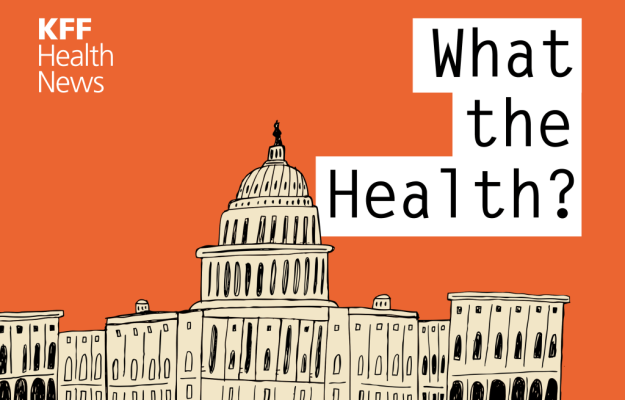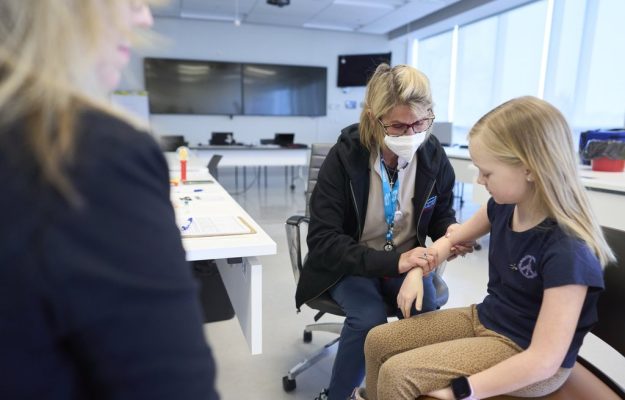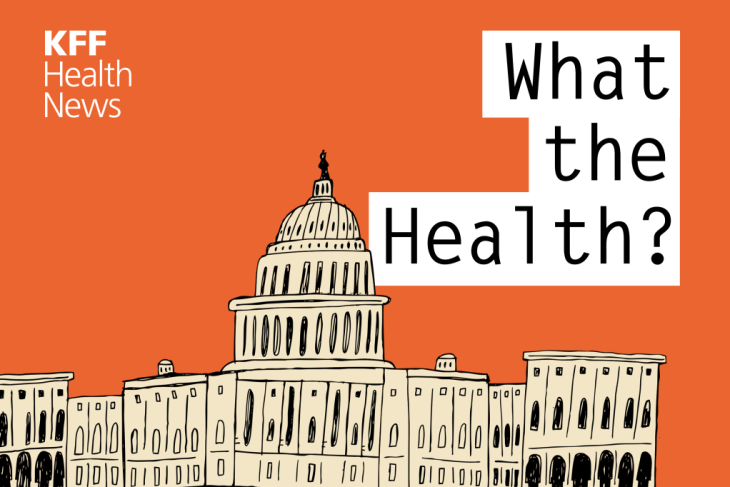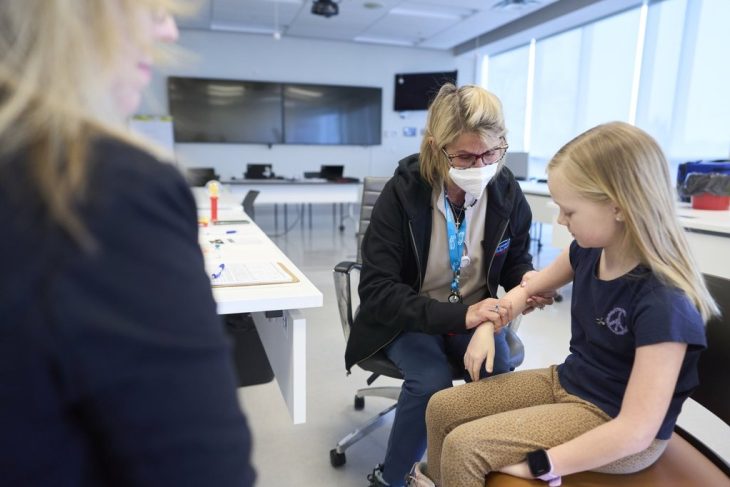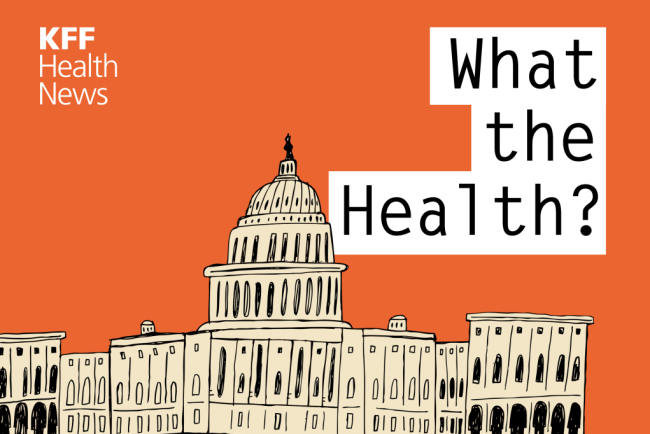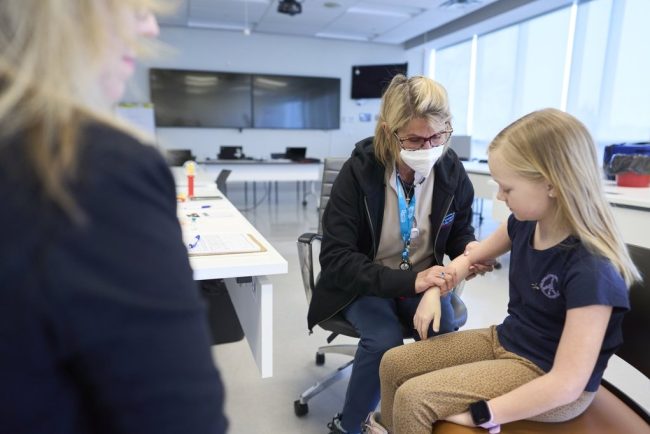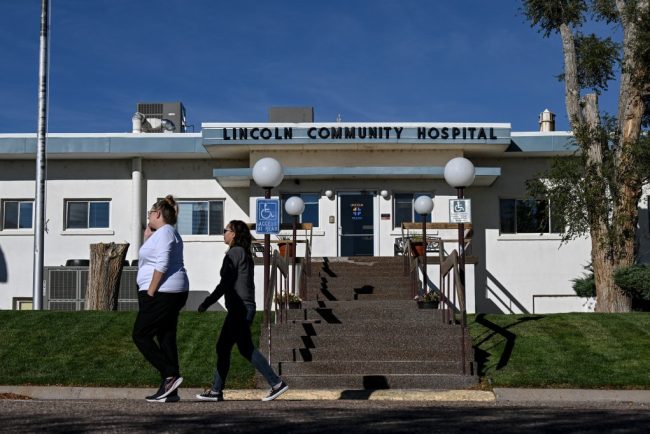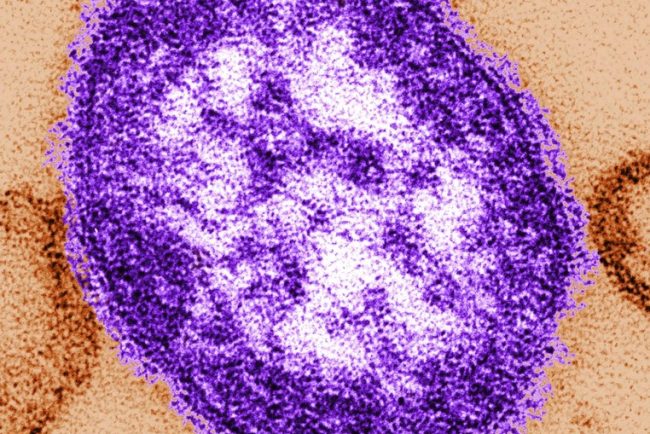
Alberta Medical Association warns measles will rise, says ramped-up health campaign needed
Alberta Medical Association president Dr. Shelley Duggan says the numbers suggest that within weeks, the numbers could skyrocket.
Measles
Transplant recipients and other immunocompromised people worry about measles exposure
Laurie Miller, a heart transplant patient exposed to measles in Stratford, Ont., says her story speaks to the risks people who are immunocompromised face during an outbreak.
Measles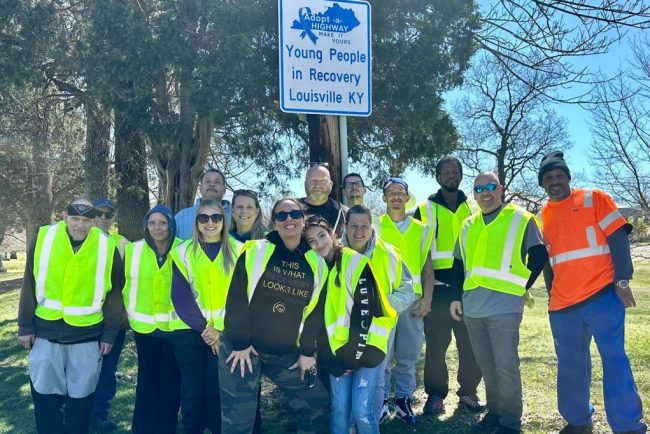
Moms in Crisis, Jobs Lost: The Human Cost of Trump’s Addiction Funding Cuts
When the Trump administration cut more than $11 billion in covid-era funds to states in late March, addiction recovery programs suffered swift losses. An Indiana organization that employs people in recovery to help peers with substance use disorders and mental illness was forced to lay […]
Health Care
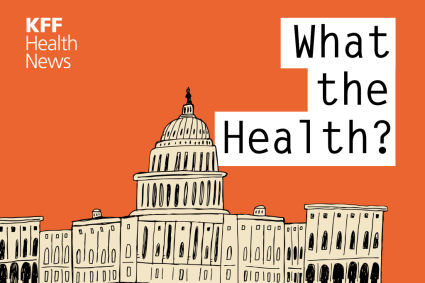
KFF Health News' 'What the Health?': Federal Health Work in Flux
The Host Julie Rovner KFF Health News @jrovner Read Julie’s stories. Julie Rovner is chief Washington correspondent and host of KFF Health News’ weekly health policy news podcast, “What the Health?” A noted expert on health policy issues, Julie is the author of the critically […]
Health CareThe Host
Julie Rovner
KFF Health News
Julie Rovner is chief Washington correspondent and host of KFF Health News’ weekly health policy news podcast, “What the Health?” A noted expert on health policy issues, Julie is the author of the critically praised reference book “Health Care Politics and Policy A to Z,” now in its third edition.
Two months into the new administration, federal workers and contractors remain off-balance as the Trump administration ramps up its efforts to cancel jobs and programs — even as federal judges declare many of those efforts illegal and/or unconstitutional.
As it eliminates programs deemed duplicative or unnecessary, however, President Donald Trump’s Department of Government Efficiency is also cutting programs and workers aligned with Health and Human Services Secretary Robert F. Kennedy Jr.’s “Make America Healthy Again” agenda.
This week’s panelists are Julie Rovner of KFF Health News, Jessie Hellmann of CQ Roll Call, Sarah Karlin-Smith of the Pink Sheet, and Rachel Roubein of The Washington Post.
Panelists
Jessie Hellmann
CQ Roll Call
Sarah Karlin-Smith
Pink Sheet
Rachel Roubein
The Washington Post
Among the takeaways from this week’s episode:
- Kennedy’s comments this week about allowing bird flu to spread unchecked through farms provided another example of the new secretary of health and human services making claims that lack scientific support and could instead undermine public health.
- The Trump administration is experiencing more pushback from the federal courts over its efforts to reduce and dismantle federal agencies, and federal workers who have been rehired under court orders report returning to uncertainty and instability within government agencies.
- The second Trump administration is signaling it plans to dismantle HIV prevention programs in the United States, including efforts that the first Trump administration started. A Texas midwife is accused of performing illegal abortions. And a Trump appointee resigns after being targeted by a Republican senator.
Plus, for “extra credit,” the panelists suggest health policy stories they read this week that they think you should read, too:
Julie Rovner: The Washington Post’s “The Free-Living Bureaucrat,” by Michael Lewis.
Rachel Roubein: The Washington Post’s “Her Research Grant Mentioned ‘Hesitancy.’ Now Her Funding Is Gone.” by Carolyn Y. Johnson.
Sarah Karlin-Smith: KFF Health News’ “Scientists Say NIH Officials Told Them To Scrub mRNA References on Grants,” by Arthur Allen.
Jessie Hellmann: Stat’s “NIH Cancels Funding for a Landmark Diabetes Study at a Time of Focus on Chronic Disease,” by Elaine Chen.
Also mentioned in this week’s podcast:
- The Wall Street Journal’s “Trump Administration Weighing Major Cuts to Funding for Domestic HIV Prevention,” by Liz Essley White, Dominique Mosbergen, and Jonathan D. Rockoff.
- The Washington Post’s “Disabled Americans Fear Losing Protections if States’ Lawsuit Succeeds,” by Amanda Morris.
click to open the transcript
Transcript: Federal Health Work in Flux
[Editor’s note: This transcript was generated using both transcription software and a human’s light touch. It has been edited for style and clarity.]
Julie Rovner: Hello, and welcome back to “What the Health?” I’m Julie Rovner, chief Washington correspondent for KFF Health News, and I’m joined by some of the best and smartest health reporters in Washington. We’re taping this week on Thursday, March 20, at 10 a.m. As always, news happens fast and things might have changed by the time you hear this. So, here we go.
Today we are joined via videoconference by Rachel Roubein of The Washington Post.
Rachel Roubein: Hi.
Rovner: Sarah Karlin-Smith of the Pink Sheet.
Sarah Karlin-Smith: Hi, everybody.
Rovner: And Jessie Hellmann of CQ Roll Call.
Jessie Hellmann: Hello.
Rovner: No interview today, but, as usual, way more news than we can get to, so let us jump right in. In case you missed it, there’s a bonus podcast episode in your feed. After last week’s Senate Finance Committee confirmation hearing for Dr. Mehmet Oz to head the Centers for Medicare & Medicaid Services, my KFF Health News colleagues Stephanie Armour and Rachana Pradhan and I summarized the hearing and caught up on all the HHS [Department of Health and Human Services] nomination actions. It will be the episode in your feed right before this one.
So even without Senate-confirmed heads at — checks notes — all of the major agencies at HHS, the department does continue to make news. First, Robert F. Kennedy Jr., the new HHS secretary, speaks. Last week it was measles. This week it was bird flu, which he says should be allowed to spread unchecked in chicken flocks to see which birds are resistant or immune. This feels kind of like what some people recommended during covid. Sarah, is there any science to suggest this might be a good idea?
Karlin-Smith: No, it seems like the science actually suggests the opposite, because doctors and veterinary specialists are saying basically every time you let the infection continue to infect birds, you’re giving the virus more and more chances to mutate, which can lead to more problems down the road. The other thing is they were talking about the way we raise animals, and for food these days, there isn’t going to be a lot of genetic variation for the chickens, so it’s not like you’re going to be able to find a huge subset of them that are going to survive bird flu.
And then the other thing I thought is really interesting is just it doesn’t seem economically to make the most sense either as well, both for the individual farmers but then for U.S. industry as a whole, because it seems like other countries will be particularly unhappy with us and even maybe put prohibitions on trading with us or those products due to the spread of bird flu.
Rovner: Yeah, it was eyebrow-raising, let us say. Well, HHS this week also announced its first big policy effort, called Operation Stork Speed. It will press infant formula makers for more complete lists of ingredients, increase testing for heavy metals in formula, make it easier to import formula from other countries, and order more research into the health outcomes of feeding infant formula. This feels like maybe one of those things that’s not totally controversial, except for the part that the FDA [Food and Drug Administration] workers who have been monitoring the infant formula shortage were part of the big DOGE [Department of Government Efficiency] layoffs.
Roubein: I talked to some experts about this idea, and, like you said, they thought it kind of sounded good, but they basically needed more details. Like, what does it mean? Who’s going to review these ingredients? To your point, some people did say that the agency would need to staff up, and there was a neonatologist who is heading up infant formula that was hired after the 2022 shortage who was part of the probationary worker terminations. However, when the FDA rescinded the terminations of some workers, so, that doctor has been hired back. So I think that’s worth noting.
Rovner: Yes. This is also, I guess, where we get to note that Calley Means, one of RFK Jr.’s, I guess, brain trusts in the MAHA movement, has been hired as, I guess, in an Elon Musk-like position in the White House as an adviser. But this is certainly an area where he would expect to weigh in.
Hellmann: Yeah, I saw he’s really excited about this on Twitter, or X. There’s just been concerns in the MAHA movement, “Make America Healthy Again,” about the ingredients that are in baby formula. And the only thing is I saw that he also retweeted somebody who said that “breast is best,” and I’m just hoping that we’re not going back down that road again, because I feel like public health did a lot of work in pushing the message that formula and breast milk is good for the child, and so that’s just another angle that I’ve been thinking about on this.
Rovner: Yes, I think this is one of those things that everybody agrees we should look at and has the potential to get really controversial at some point. While we are on the subject of the federal workforce and layoffs, federal judges and DOGE continue to play cat-and-mouse, with lots of real people’s lives and careers at stake. Various judges have ordered the reinstatement, as you mentioned, Rachel, of probationary and other workers. Although in many cases workers have been reinstated to an administrative leave status, meaning they get put back on the payroll and they get their benefits back, but they still can’t do their jobs. At least one judge has said that does not satisfy his order, and this is all changing so fast it’s basically impossible to keep up. But is it fair to say that it’s not a very stable time to be a federal worker?
Karlin-Smith: That’s probably the nicest possible way to put it. When you talk to federal workers, everybody seems stressed and just unsure of their status. And if they do have a job, it’s often from their perspective tougher to do their job lately, and then they’re just not sure how stable it is. And many people are considering what options they have outside the federal government at this point.
Rovner: So for those lucky federal workers who do still have jobs, the Trump administration has also ordered everyone back to offices, even if those offices aren’t equipped to accommodate them. FDA headquarters here in Maryland’s kind of been the poster child for this this week.
Karlin-Smith: Yeah, FDA is an interesting one because well before covid normalized working from home and transitioned a lot of people to working from home, FDA’s headquarters couldn’t accommodate a lot of the new growth in the agency over the years, like the tobacco part of the FDA. So it was typical that people at least worked part of their workweek at home, and FDA really found once covid gave them additional work-from-home flexibilities, they were able to recruit staff they really, really needed with specialized degrees and training who don’t live near here, and it actually turned out to be quite a benefit from them.
And now they’re saying everybody needs to be in an office five days a week, and you have people basically cramped into conference rooms. There’s not enough parking. People are trying to review technical scientific data, and you kind of can’t hear yourself think. Or you’re a lawyer — I heard of a situation where people are basically being told, Well, if you need to do a private phone call because of the confidentiality around what you’re doing, go take the call in your car. So I think in addition to all of the concerns people have around the stability of their jobs, there’s now this element of, on a personal level, I think for many of them it’s just made their lives more challenging. And then they just feel like they’re not actually able to do, have the same level of efficiency at their work as they normally would.
Rovner: And for those who don’t know, the FDA campus is on a former military installation in the Maryland suburbs. It’s not really near any public transportation. So you pretty much have to drive to get there. And I think that the parking lots are not that big, because, as you pointed out, Sarah, the workforce is now bigger than the headquarters was created to accommodate it. And we’re seeing this across the government. This week it happened to be FDA. You have to ask the question: Is this really just an effort to make the government not work, to make federal workers, if they can’t fire them, to make them quit?
Hellmann: I definitely think that’s part of the underlying goal. If you see some of the stuff that Elon Musk says about the federal workforce, it’s very dismissive. He doesn’t seem to have a lot of respect for the civil servants. And they’ve been running into a lot of pushback from federal judges over many lawsuits targeting these terminations. And so I think just making conditions as frustrating as possible for some of these workers until they quit is definitely part of the strategy.
Roubein: And I think this is overlaid with the additional buyout offers, the additional early retirement offers. There’s also the reduction-in-force plans that federal workers have been unnerved about, bracing for future layoffs. So it’s very clear that they want to shrink the size of the federal workforce.
Rovner: Yeah, we’ve seen a lot of these people, I’ve seen interviews with them, who are being reinstated, but they’re still worried that now they’re going to be RIF-ed. They’re back on the payroll, they’re off the payroll. I mean there’s nothing — this does not feel like a very efficient way to run the federal government.
Karlin-Smith: Right. I think that’s what a lot of people are talking about is, again, going back to offices, for many of these people, is not leading to productivity. I talked to one person who said: I’m just leaving my laptop at the office now. I’m not going to take it home and do the extra hours of work that they might’ve normally gotten from me. And that includes losing time to commute. FDA is paying for parking-garage spaces in downtown Silver Spring [Maryland] near the Metro so that they can then shuttle people to the FDA headquarters. I’ve taken buses from that Metro to FDA headquarters. In traffic, that’s a 30-minute drive. They’re spending money on things that, again, I think are not going to in the long run create any government efficiency.
And in fact, I’ve been talking to people who are worried it’s going to do the opposite, that drug review, device review, medical product review times and things like that are going to slow. We talked about food safety. I think The New York Times had a really good story this week about concerns about losing the people. We need to make sure that baby formula is actually safe. So there’s a lot of contradictions in the messaging of what they’re trying to accomplish and how the actions actually are playing out.
Rovner: Well, and finally, I’m going to lay one more layer on this. There’s the question of whether you can even put the toothpaste back in the tube if you wanted to. After weeks of back-and-forth, the federal judge ruled on Tuesday that the dissolution of USAID [the U.S. Agency for International Development] was illegal and probably unconstitutional, and ordered email and computer access restored for the remaining workers while blocking further cuts. But with nearly everybody fired, called back from overseas, and contracts canceled, USAID couldn’t possibly come close to doing what it did before DOGE basically took it apart, right?.
Karlin-Smith: You hear stories of if someone already takes a new job, they’re lucky enough to find a new job, why are they going to come back? Again, even if you’re brought back, my expectation is a lot of people who have been brought back are probably looking for new jobs regardless because you don’t have that stability. And I think the USAID thing is interesting, too, because again, you have people that were working in all corners of the world and you have partnerships with other countries and contractors that have to be able to trust you moving forward. And the question is, do those countries and those organizations want to continue working with the U.S. if they can’t have that sort of trust? And as people said, the U.S. government was known as, they could pay contractors less because they always paid you. And when you take that away, that creates a lot of problems for negotiating deals to work with them moving forward.
Rovner: And I think that’s true for federal workers, too. There’s always been the idea that you probably could earn more in the private sector than you can working for the federal government, but it’s always been a pretty stable job. And I think right now it’s anything but, so comes the question of: Are we deterring people from wanting to work for the federal government? Eventually one would assume there’s still going to be a federal government to work for, and there may not be anybody who wants to do it.
Roubein: Yeah, you saw various hiring authorities given to try and recruit scientists and other researchers who make a lot, lot more in the public health sector, and some of those were a part of the probationary workforce because they had been hired recently under those authorities.
Rovner: Yeah, and now this is all sort of coming apart. Well, meanwhile, the cuts are continuing even faster than federal judges can rule against them. Last week, the administration said it would reduce the number of HHS regional offices from 10 to four. Considering these are where the department’s major fraud-fighting efforts take place, that doesn’t seem a very effective way of going after fraud and abuse in programs like Medicare and Medicaid. Those regional offices are also where lots of beneficiary protections come from, like inspections of nursing homes and Head Start facilities. How does this serve RFK Jr.’s Make America Healthy Again agenda?
Karlin-Smith: I think it’s not clear that it does, right? You’re talking about, again, the Department of Government Efficiency has focused on efficiency, cost savings, and Medicare and Medicaid does a pretty good job of fighting fraud and making HHS OIG [Office of Inspector General], all those organizations, they collect a lot of money back. So when you lose people—
Rovner: And of course the inspector general has also been laid off in all of this.
Karlin-Smith: Right. It’s not clear to me, I think one of the things with that whole reorganization of their chief counsel is people are suggesting, again, this is sort of a power move of HHS wanting to get a little bit more control of the legal operations at the lower agencies, whether it’s NIH [the National Institutes of Health] or FDA and so forth. But, right, it’s reducing head count without really thinking about what people’s roles actually were and what you lose when you let them go.
Rovner: Well, the Trump administration is also continuing to cut grants and contracts that seem like they’d be the kind of things that directly relate to Make America Healthy Again. Jessie, you’ve chosen one of those as your extra credit this week. Tell us about it.
Hellmann: Yeah. So my story is from Stat [“NIH Cancels Funding for a Landmark Diabetes Study at a Time of Focus on Chronic Disease”], and it’s about a nationwide study that tracks patients with prediabetes and diabetes. And it was housed at Columbia University, which as we know has been the subject of some criticism from the Trump administration. They had lost about $400 million in grants because the administration didn’t like Columbia’s response to some of the protests that were on campus last year. But that has an effect on some research that really doesn’t have much to do with that, including a study that looked at diabetes over a really long period of time.
So it was able to over decades result in 200 publications about prediabetes and diabetes, and led to some of the knowledge that we have now about the interventions for that. And the latest stage was going to focus on dementia and cognitive impairment, since some of the people that they’ve been following for years are now in their older ages. And now they have to put a stop to that. They don’t even have funding to analyze blood samples that they’ve done and the brain scans that they’ve collected. So it’s just another example of how what’s being done at the administration level is contradicting some of the goals that they say that they have.
Rovner: Yeah, and it’s important to remember that Columbia’s funding is being cut not because they deemed this particular project to be not helpful but because they are, as you said, angry at Columbia for not cracking down more on pro-Palestinian protesters after Oct. 7.
Well, meanwhile, people are bracing for still more cuts. The Wall Street Journal is reporting the administration plans to cut domestic AIDS-HIV programming on top of the cuts to the international PEPFAR [President’s Emergency Plan for AIDS Relief] program that was hammered as part of the USAID cancellation. Is fighting AIDS and HIV just way too George W. Bush for this administration?
Hellmann: It’s interesting because President [Donald] Trump unveiled the Ending the HIV Epidemic initiative in his first term, and the goal was to end the epidemic in the United States. And so if they were talking about reducing some of that funding, or I know there were reports that maybe they would move the funding from CDC [the Centers for Disease Control and Prevention] to HRSA [the Health Resources and Services Administration], it’s very unclear at this point. Then it raises questions about whether it would undermine that effort. And there’s already actions that the Trump administration has done to undermine the initiative, like the attacks on trans people. They’ve canceled grants to researchers studying HIV. They have done a whole host of things. They canceled funding to HIV services organizations because they have “trans” in their programming or on their websites. So it’s already caused a lot of anxiety in this community. And yeah, it’s just a total turnaround from the first administration.
Rovner: I know the Whitman-Walker clinic here in Washington, which has long been one of the premier AIDS-HIV clinics, had just huge layoffs. This is already happening, and as you point out, this was something that President Trump in his first term vowed to end AIDS-HIV in the U.S. So this is not one would think how one would go about that.
Well, it’s not just the administration that’s working to constrict rights and services. A group of 17 states, led by Texas, of course, are suing to have Biden-era regulations concerning discrimination against trans people struck down, except as part of that suit, the states are asking that the entirety of Section 504 of the Rehabilitation Act be declared unconstitutional. Now, you may never have heard of Section 504, but it is a very big deal. It was the forerunner of the Americans With Disabilities Act, and it prevents discrimination on the basis of disability in all federally funded activities. It is literally a lifeline for millions of disabled people that enables them to live in the community rather than in institutions. Are we looking at an actual attempt to roll back basically all civil rights as part of this war on “woke” and DEI [diversity, equity, and inclusion] and trans people?
Hellmann: The story is interesting, because it seems like some of the attorneys general are saying, That’s not our intent. But if you look at the court filings, it definitely seems like it is. And yeah, like you said, this is something that would just have a tremendous impact. And Medicaid coverage of home- and community-based services is one of those things that states are constantly struggling to pay for. You’re just continuing to see more and more people need these services. Some states have waiting lists, so—
Rovner: I think most states have waiting lists.
Hellmann: Yeah. It’s something, you have to really question what the intent is here. Even if people are saying, This isn’t our intent, it’s pretty black-and-white on paper in the court records, so—
Rovner: Yeah, just to be clear, this was a Biden administration regulation, updating the rules for Section 504, that included reference to trans people. But in the process of trying to get that struck down, the court filings do, as you say, call for the entirety of Section 504 to be declared unconstitutional. This is obviously one of those court cases that’s still before the district court, so it’s a long way to go. But the entire disability community, certainly it has their attention.
Well, we haven’t had any big abortion news the past couple of weeks, but that is changing. In Texas, a midwife and her associate have become the first people arrested under the state’s 2022 abortion ban. The details of the case are still pretty fuzzy, but if convicted, the midwife who reportedly worked as an OB-GYN doctor in her native Peru and served a mostly Spanish-speaking clientele, could be sentenced to up to 20 years in prison. So, obviously, be watching that one. Meanwhile, here in Washington, Hilary Perkins, a career lawyer chosen by FDA commissioner nominee Marty Makary to serve as the agency’s general counsel, resigned less than two days into her new position after complaints from Missouri Sen. Josh Hawley that she defended the Biden administration’s position on the abortion pill mifepristone.
Now, Hilary Perkins is no liberal trying to hide out in the bureaucracy. She’s a self-described pro-life Christian conservative hired in the first Trump administration, but she was apparently forced out for the high crime of doing her job as a career lawyer. Is this administration really going to try to evict anyone who ever supported a Biden position? Will that leave anybody left?
Roubein: I think what’s notable is Sen. Josh Hawley here, who expressed concerns and I had heard expressed concerns to the White House, and the post on X from the FDA came an hour before the hearing. There were concerns that he was not going to make it out of committee and—
Rovner: Before the Marty Makary hearing.
Roubein: Yes, sorry, before the vote in the HELP [Health, Education, Labor and Pensions] Committee on Marty Makary. And Hawley said because of that, he would vote to support him. What was interesting is two Democrats actually ended up supporting him, so he could have passed without Hawley’s vote. But I think in general it poses a test for Marty Makary when he’s an FDA commissioner, and how and whether he’s going to get his people in and how he’ll respond to different pressure points in Congress and with HHS and with the White House.
Rovner: And of course, Hawley’s not a disinterested bystander here, right?
Karlin-Smith: So his wife was one of the key attorneys in the recent big Supreme Court case that was pushed down to the lower courts for a lack of standing, but she was trying to essentially get tighter controls on the abortion pill mifepristone. But it seems like almost maybe Hawley jumped too soon before doing all of his research or fully understanding the role of people at Justice. Because even before this whole controversy erupted, I had talked to people the day before about this and asked them, “Should we read into this, her being involved in this?” And everybody I talked to, including, I think, a lot of people that have different views than Perkins does on the case, that they were saying she was in a role as a career attorney. You do what your boss, what the administration, wants.
If you really, really had a big moral problem with that, you can quit your job. But it’s perfectly normal for an attorney in that kind of position to defend a client’s interest and then have another client and maybe have to defend them wrongly. So it seems like if they had just maybe even picked up the phone and had a conversation with her, the whole crisis could have been averted. And she was on CNN yesterday trying to plead her case and, again, emphasize her positions because perhaps she’s worried about her future career prospects, I guess, over this debacle.
Rovner: Yeah, now she’s going to be blackballed by both sides for having done her job, basically. Anyway, all right, well, one big Biden initiative that looks like it will continue is the Medicare Drug Price Negotiation program. And we think we know this because CMS announced last week that the makers of all of the 15 drugs selected for the second round of negotiations have agreed to, well, negotiate. Sarah, this is news, right? Because we were wondering whether this was really going to go forward.
Karlin-Smith: Yeah, they’ve made some other signals since taking over that they were going to keep going with this, including last week at his confirmation hearing, Dr. Oz, for CMS, also indicated he seemed like he would uphold that law and they were looking for ways to lower drug costs. So I think what people are going to be watching for is whether they yield around the edges in terms of tweaks the industry wants to the law, or is there something about the prices they actually negotiate that signal they’re not really trying to get them as low as they can go? But this seems to be one populist issue for Trump that he wants to keep leaning into and keep the same consistency, I think, from his first administration, where he always took a pretty hard line on the drug industry and drug pricing.
Rovner: And I know Ozempic is on that list of 15 drugs, but the administration hasn’t said yet. I assume that’s Ozempic for its original purpose in treating diabetes. This administration hasn’t said yet whether they’ll continue the Biden declaration that these drugs could be available for people for weight loss, right?
Karlin-Smith: Correct. And I think that’s going to be more complicated because that’s so costly. So negotiating the price of drugs saves money. So yes, basically because Ozempic and Wegovy are the same drug, that price should be available regardless of the indication. But I’m more skeptical that they continue that policy, because of the cost and also just because, again, HHS Secretary Robert F. Kennedy seems to be particularly skeptical of the drugs, or at least using that as a first line of defense, widespread use, reliance on that. He tends to, in general, I think, support other ways of medical, I guess, treatment or health treatments before turning to pharmaceuticals.
Rovner: Eating better and exercising.
Karlin-Smith: Correct, right. So I think that’s going to be a hard sell for them because it’s just so costly.
Rovner: We will see. All right, that is as much news as we have time for this week. Now, it is time for our extra-credit segment, that’s where we each recognize the story we read this week we think you should read, too. Don’t worry if you miss it. We will put the links in our show notes on your phone or other mobile device. Jessie, you’ve done yours already this week. Rachel, why don’t you go next?
Roubein: My extra credit, the headline is “Her Research Grant Mentioned ‘Hesitancy.’ Now Her Funding Is Gone.” In The Washington Post by my colleague Carolyn Y. Johnson. And I thought the story was particularly interesting because it really dove into the personal level. You hear about all these cuts from a high level, but you don’t always really know what it means and how it came about. So the backstory is the National Institutes of Health terminated dozens of research grants that focused on why some people are hesitant to accept vaccines.
And Carolyn profiled one researcher, Nisha Acharya, but there was a twist, and the twist was she doesn’t actually study how to combat vaccine hesitancy or ways to increase vaccine uptake. Instead, she studies how well the shingles vaccine works to prevent the infection, with a focus on whether the shot also prevents the virus from affecting people’s eyes. But in the summary of her project, she had used the word “hesitancy” once and used the word “uptake” once. And so this highlights the sweeping approach to halting some of these vaccine hesitancy research grants.
Rovner: Yeah that was like the DOD [Department of Defense] getting rid of the picture of the Enola Gay, the plane that dropped the atomic bomb, because it had the word “Gay” in it. This is the downside, I guess, of using AI for these sorts of things. Sarah.
Karlin-Smith: I took a look at a KFF story by Arthur Allen, “Scientists Say NIH Officials Told Them to Scrub mRNA References on Grants,” and it’s about NIH officials urging people to remove any reference to mRNA vaccine technology from their grants. And the story indicates it’s not yet clear if that is going to translate to defunding of such research, but the implications are quite vast. I think most people probably remember the mRNA vaccine technology is really what helped many of us survive the covid pandemic and is credited with saving millions of lives, but the technology promise seems vast even beyond infectious diseases, and there’s a lot of hope for it in cancer.
And so this has a lot of people worried. It’s not particularly surprising, I guess, because again, the anti-vaccine movement, which Kennedy has been a leader of, has been particularly skeptical of the mRNA technology. But it is problematic, I think, for research. And we spent a lot of time on this call talking about the decimation of the federal workforce that may happen here, and I think this story and some of the other things we talked about today also show how we may just decimate our entire scientific research infrastructure and workforce in the U.S. outside of just the federal government, because so much of it is funded by NIH, and the decisions they’re making are going to make it impossible for a lot of scientists to do their job.
Rovner: Yeah, we’re also seeing scientists going to other countries, but that’s for another time. Well, my extra credit this week, probably along the same lines, also from The Washington Post. It’s part of a series called “Who Is Government?” This particular piece [“The Free-Living Bureaucrat”] is by bestselling author Michael Lewis, and it’s a sprawling — and I mean sprawling — story of how a mid-level FDA employee who wanted to help find new treatments for rare diseases ended up not only figuring out a cure for a child who was dying of a rare brain amoeba but managed to obtain the drug for the family in time to save her. It’s a really good piece, and it’s a really excellent series that tells the stories of mostly faceless bureaucrats who actually are working to try to make the country a better place.
OK, that’s this week’s show. As always, if you enjoy the podcast, you can subscribe wherever you get your podcasts. We’d appreciate it if you left us a review. That helps other people find us, too. Thanks as always to our producer, Francis Ying, and our editor, Emmarie Huetteman. As always, you can email us your comments or questions. We’re at whatthehealth@kff.org, or you can still find me at X, @jrovner, and at Bluesky, @julierovner. Where are you guys these days? Sarah?
Karlin-Smith: A little bit everywhere. X, Bluesky, LinkedIn — @SarahKarlin or @sarahkarlin-smith.
Rovner: Jessie.
Hellmann: I’m @jessiehellmann on X and Bluesky, and I’m also on LinkedIn more these days.
Rovner: Great. Rachel.
Roubein: @rachelroubein at Bluesky, @rachel_roubein on X, and also on LinkedIn.
Rovner: We will be back in your feed next week. Until then, be healthy.
Credits
Francis Ying
Audio producer
Emmarie Huetteman
Editor
To hear all our podcasts, click here.
And subscribe to KFF Health News’ “What the Health?” on Spotify, Apple Podcasts, Pocket Casts, or wherever you listen to podcasts.
KFF Health News is a national newsroom that produces in-depth journalism about health issues and is one of the core operating programs at KFF—an independent source of health policy research, polling, and journalism. Learn more about KFF.
USE OUR CONTENT
This story can be republished for free (details).

Ontario sees another sharp increase in measles cases over a week
Ontario has seen another sharp increase in measles cases over the last week as the highly infectious disease spreads among mostly unvaccinated people.
MeaslesOntario has seen another sharp increase in measles cases over the last week as the highly infectious disease spreads among mostly unvaccinated people.
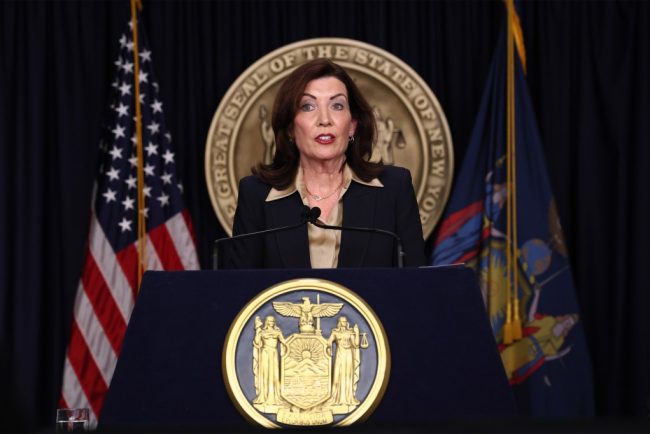
In New York, Providers Must Put Patient Costs on the Table
The routine is familiar for most people: When checking in for an appointment with a doctor or other health care provider, patients typically complete and sign a pile of paperwork, including a form that contains some version of the statement, “I agree to pay for […]
Health CareThe routine is familiar for most people: When checking in for an appointment with a doctor or other health care provider, patients typically complete and sign a pile of paperwork, including a form that contains some version of the statement, “I agree to pay for all charges not covered by my insurance company.”
Patients may not feel comfortable making that financial promise, often before they have any idea what the charges will be. But they generally sign the form anyway, because the alternative is often not to get the services they’re seeking.
As a result, consumers may be responsible for unexpected bills and at risk for medical debt.
In New York, state officials, advocates, and the health care provider community have been engaged in a policy tug-of-war over efforts to protect consumers. Their advocates don’t want them to get stuck signing “blank check” forms that put them in financial jeopardy. Doctors, hospitals, and other providers don’t want to disrupt their practices’ workflow and payment logistics with cost discussions and paperwork, especially after services have been provided. State officials’ efforts to find a satisfying compromise have so far fallen short.
At the center is a state law that took effect last fall to prohibit requiring patients to sign such consent-to-pay forms before they’ve received treatment and discussed the costs.
Legal analysts described it as the first such law in the country. Physician groups cried foul, saying it would raise payment issues and other significant logistical problems.
Those concerns found traction. Shortly before the law’s start date, the state’s Department of Health delayed its implementation indefinitely. In addition, Democratic Gov. Kathy Hochul’s proposed fiscal year 2026 budget would let providers go back to requiring patients to agree to pay for care in advance of receiving treatment. It also clarified that the consent requirements would not apply to emergency care.
A key provision of the new law would remain in place, however: Doctors and other providers would still be obligated to have the cost discussion with patients before the patient is asked to sign the form agreeing to pay for the service. Some consider this a significant step.
“Providers having an affirmative obligation to discuss treatment costs is unique,” said Gregory Mitchell, a partner in the health and life sciences practice group at McDermott Will & Emery law firm who specializes in managed care. Clients from around the country have been reaching out to the law firm with questions.
Requiring providers to discuss costs with patients, whether before or after services are provided, would pose a “significant burden,” he said. Doctors and other providers typically don’t know specifics about patient deductibles, cost sharing, or other insurance coverage details until after a claim is submitted to a health plan.
Health care services are different than refrigerators or other goods that people buy, doctors say. If a patient gets a colonoscopy and doesn’t want to pay for it, “it’s not possible to take the service back,” said Jerome Cohen, a gastroenterologist and the president of the Medical Society of the State of New York, which represents physicians. As for the proposed changes in the 2026 budget, Cohen said the medical society “very much appreciates the governor’s efforts to try to fix this problematic financial consent requirement.”
But patient advocates are pushing back. The current practice is “unfair and it’s wrong,” said Elisabeth Benjamin, vice president of health initiatives at the Community Service Society of New York, a nonprofit that has successfully pushed for passage of several medical debt-related laws in recent years. No patient should ever have to preemptively agree to pay whatever a provider charges, Benjamin said.
In a written response to questions, Danielle De Souza, a spokesperson for the state Department of Health, said that the proposed law change is justified, “given the burden of this requirement on both patients and providers.” De Souza didn’t respond to a request for clarification about what those patient burdens are.
Helen Krim walked out of a doctor’s office in the Bronx borough of New York City a few years ago rather than sign an open-ended form agreeing to pay for any services recommended by the doctor.
It was the first time that Krim, who is covered by Medicare, had visited that primary care practice. When she told them she didn’t want to sign the form, she was told they wouldn’t serve her unless she did.
“I’m one of those annoying people who actually reads the forms,” the retired bank project manager said. “It’s kind of like signing a consent to be scammed.” She found another practice that didn’t ask her to sign a similar form.
There are other consumer medical debt protections at the federal and state level. The federal No Surprises Act restricts providers from billing consumers for out-of-network services in certain instances. It also requires providers to give good-faith cost estimates for self-pay patients. The Consumer Financial Protection Bureau released a final rule in January that would have removed medical debt from people’s credit reports, but the rule’s implementation has been frozen by the Trump administration. Several states besides New York have also taken steps to protect consumers with medical debt.
Benjamin said that simply requiring an unspecified “discussion” about costs doesn’t address patients’ potential unlimited financial liability. Under a bill that Benjamin’s organization has drafted, providers would have to give patients a written good-faith estimate of their expected costs before the patient receives services and patients could not be held liable for unlimited or unspecified costs beyond that estimate.
“Let’s be the first state to really have fair rules of engagement for both the providers and the patients about what is it that you’re agreeing to be financially liable for at the point, beforehand,” Benjamin said.
The measure was introduced in the Senate this month.
Providers are taking a wait-and-see attitude, Mitchell said, because the budget plan must still move through the legislative process.
Another New York medical debt-related law that took effect in October takes aim at the use of credit cards to pay for medical services. The Hochul administration has not proposed changing it. The law prohibits providers from requiring pre-authorization of credit cards or keeping a patient’s card on file. It also requires providers to notify patients of the risks of paying for medical care with credit cards, which may lack medical debt protections. In addition, providers aren’t allowed to help patients complete credit card applications under the law.
The laws are aimed at stopping unfair billing practices and reducing medical debt for New Yorkers. Earlier laws ban credit reporting of all medical debt and prohibit hospitals from suing patients with incomes under 400% of the poverty level, among other things.
New York providers don’t like the credit card law either, though it hasn’t generated the pushback seen with the consent-to-pay law.
In a statement, Brian Conway, a spokesperson for the Greater New York Hospital Association, said, “It’s important to clarify that hospitals do not oppose the goals of the hospital financial assistance law reforms overall, but rather the operational burdens and patient disclosure overload that a few specific provisions create.”
KFF Health News is a national newsroom that produces in-depth journalism about health issues and is one of the core operating programs at KFF—an independent source of health policy research, polling, and journalism. Learn more about KFF.
USE OUR CONTENT
This story can be republished for free (details).

Low measles vaccine rates in parts of B.C. calls for open discussion: experts
The B.C. Centre for Disease Control provides stats on vaccination rates and it shows there are areas where children are not keeping up to date with their measles vaccine.
MeaslesThe B.C. Centre for Disease Control provides stats on vaccination rates and it shows there are areas where children are not keeping up to date with their measles vaccine.

Indiana Lawmakers Seek To Forbid Hospital Monopolies, but One Merger Fight Remains
Union Health is making a new bid to Indiana regulators to buy its rival hospital in Terre Haute as the door looks poised to close on such deals. The nonprofit health system is trying to leverage an existing state law to acquire Terre Haute Regional […]
Rural HealthUnion Health is making a new bid to Indiana regulators to buy its rival hospital in Terre Haute as the door looks poised to close on such deals.
The nonprofit health system is trying to leverage an existing state law to acquire Terre Haute Regional Hospital, the only other acute care hospital in Vigo County. After withdrawing its initial application in November amid pushback, Union has shifted its pitch to emphasize what it describes as Regional’s “declining position” while offering more concrete promises, such as limits on price increases.
Union submitted its new application on Feb. 5 as Indiana lawmakers were attempting to nix such mergers in their state. Lawmakers then watered down a bill that threatened to forbid Union’s deal altogether, with the amended legislation now barring mergers sought after Feb. 15, leaving an opening for Union. That means the proposed merger will next face a showdown with the administration of Indiana’s new governor, which has signaled opposition to such deals.
Indiana is among the latest states reconsidering Certificate of Public Advantage laws that greenlight hospital monopolies. This year, Tennessee lawmakers introduced a bill to restructure state oversight of these mergers after an attempt last year to repeal its COPA law. In 2023, Maine repealed its COPA law, joining Minnesota, Montana, North Carolina, and North Dakota.
“I would hope that they are reconsidering the laws because of the research on the long-run harms of COPAs,” said Christopher Garmon, a University of Missouri-Kansas City economist who has studied COPA mergers.
Indiana is one of 19 states that still have COPA laws, which allow mergers that the Federal Trade Commission otherwise considers illegal because they reduce competition and often create monopolies.
In exchange for approval of these deals, the merging hospitals typically agree to meet conditions imposed by their state to mitigate the harms of a monopoly. But health care economists and the FTC have said that state oversight cannot replace competition and that these mergers ultimately harm patients.
Union Health’s first application faced pushback. The state’s Department of Health received hundreds of comments, with most opposing the deal, according to a review of documents KFF Health News obtained through a state public records request. Doctors, health economists, and the FTC were among those who called on state regulators to deny Union’s proposal.
Union pulled its application in November, just days before the state was due to rule on the deal.
When Union filed its new application in early February, this time it promised a slew of concrete commitments and pledges to improve residents’ health in the largely rural communities that surround Terre Haute. Among them were promises to keep both hospitals’ emergency rooms open and inpatient services in operation, and to tie increases in hospital charges to the consumer price index for medical care, essentially establishing a cap so charges don’t exceed medical inflation.
It also recast its pitch to describe Regional as a hospital in decline, which Union said puts the region at risk of losing access to services if the merger is not approved. Tennessee-based HCA Healthcare owns Terre Haute Regional.
In that scenario, Union warned, if Regional were to close, the health system would essentially have a monopoly anyway, “without any oversight, terms, or conditions” of a COPA. Instead, it argued, a green light from state regulators could avert a hospital closure and guarantee state oversight of the combined hospital system.
Union’s first application did not argue that the merger was necessary for Regional to remain viable. In public comments submitted in September and March, the FTC argued to state regulators that both hospitals are “financially stable,” adding that Regional is “part of the largest hospital system in the country with tremendous financial resources.” It also cited hospital financial reporting that showed Terre Haute Regional Hospital’s profits were better than those of most other hospitals in the country.
“This repackaged COPA application presents the same problems as before,” Clarke Edwards, acting director of the FTC’s Office of Policy Planning, said in a statement on March 17 after the commission unanimously opposed the merger.
HCA did not respond to questions about Union’s characterization that Regional is a hospital in decline.
Despite Union’s assurances that the merger would benefit the region, an analysis of the first proposal found the opposite. Zack Cooper, a health economist and an associate professor at Yale University, estimated that the price of care would rise by at least 10%, 500 jobs would be lost, and nurses’ pay would decline by at least 7%.
Despite the new application and new promises, “the nature of the deal hasn’t changed,” Cooper said. He said that his findings remain unchanged and that Union stands to benefit — not the community.
“Life is easier for a firm if you face less competition,” he said. “There’s less pressure to compete on quality. There’s less pressure to compete on price.”
In January, state Sen. Ed Charbonneau, a Republican and a key architect of Indiana’s 2021 COPA law, introduced the legislation to repeal the law, which would have foreclosed Union’s chance at a possible second attempt at the merger.
In February, seated side by side at a state Senate health committee hearing, Union Health CEO Steve Holman, Terre Haute Chamber of Commerce President Kristin Craig, and state Sen. Greg Goode, a Republican representing the region, testified against the bill.
Holman told lawmakers the merger would improve the health of the region. He also noted that the hospital system had already spent $3 million on legal fees pursuing the deal. He said it seemed like lawmakers were attempting to cripple Union’s chances. “Why has this come up now?” Holman asked.
The bill to repeal the COPA law advanced out of committee by a 7-4 vote. State Sen. Mike Bohacek, a Republican who represents a region a three-hour drive north of Terre Haute, said he voted against repealing the law out of deference to local officials.
“I have no dog in this fight,” Bohacek said.
Charbonneau later amended his bill, winning support from Union and Goode. The new version sailed through the Senate. It is now backed by two powerful Republican representatives in the House: Brad Barrett, chair of the Public Health Committee, and Bob Heaton, House majority whip. Heaton represents parts of Vigo County.
Union Health spokesperson Amanda Scott said in an email to KFF Health News that Union and Regional Hospital “recognize the significance of a final approval” and that Union views this as its last chance to acquire its rival.
But Indiana’s new governor, Republican Mike Braun, took office in January vowing to crack down on consolidation, especially in health care.
Earlier this year, Braun tapped Gloria Sachdev to lead a newly created Cabinet position overseeing the state’s health care agencies, including the state Department of Health, which will decide on the merger.
As CEO of the Employers’ Forum of Indiana, a coalition of businesses that has combated high hospital prices, Sachdev was an outspoken critic of the proposed merger in Terre Haute. In an October opinion piece in The Indianapolis Star, she urged regulators to consider how these mergers can crush communities.
Sachdev, now the state’s secretary of health and family services, didn’t answer questions on the new bid. After KFF Health News asked the governor’s office whether Braun has final authority over the fate of Union’s merger request, Department of Health spokesperson Greta Sanderson provided a joint statement from the agency and the office of the governor: “Gov. Braun will expect to be informed, ask questions, and ensure that whatever decision is made is thoughtful and objective with the best interests of Hoosiers in mind.”
The state has until June 21 to review the merger application before rendering a decision, according to the Department of Health. The public can comment on the proposal through March 23.
KFF Health News is a national newsroom that produces in-depth journalism about health issues and is one of the core operating programs at KFF—an independent source of health policy research, polling, and journalism. Learn more about KFF.
USE OUR CONTENT
This story can be republished for free (details).
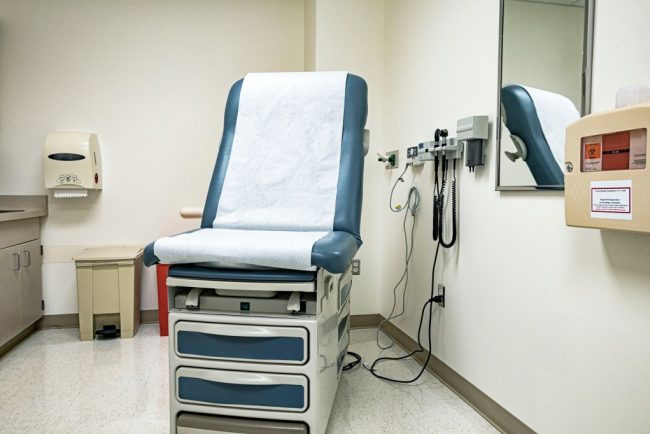
Tribal Health Leaders Say Medicaid Cuts Would Decimate Health Programs
As Congress mulls potentially massive cuts to federal Medicaid funding, health centers that serve Native American communities, such as the Oneida Community Health Center near Green Bay, Wisconsin, are bracing for catastrophe. That’s because more than 40% of the about 15,000 patients the center serves […]
Health CareAs Congress mulls potentially massive cuts to federal Medicaid funding, health centers that serve Native American communities, such as the Oneida Community Health Center near Green Bay, Wisconsin, are bracing for catastrophe.
That’s because more than 40% of the about 15,000 patients the center serves are enrolled in Medicaid. Cuts to the program would be detrimental to those patients and the facility, said Debra Danforth, the director of the Oneida Comprehensive Health Division and a citizen of the Oneida Nation.
“It would be a tremendous hit,” she said.
The facility provides a range of services to most of the Oneida Nation’s 17,000 people, including ambulatory care, internal medicine, family practice, and obstetrics. The tribe is one of two in Wisconsin that have an “open-door policy,” Danforth said, which means that the facility is open to members of any federally recognized tribe.
But Danforth and many other tribal health officials say Medicaid cuts would cause service reductions at health facilities that serve Native Americans.
Indian Country has a unique relationship to Medicaid, because the program helps tribes cover chronic funding shortfalls from the Indian Health Service, the federal agency responsible for providing health care to Native Americans.
Medicaid has accounted for about two-thirds of third-party revenue for tribal health providers, creating financial stability and helping facilities pay operational costs. More than a million Native Americans enrolled in Medicaid or the closely related Children’s Health Insurance Program also rely on the insurance to pay for care outside of tribal health facilities without going into significant medical debt. Tribal leaders are calling on Congress to exempt tribes from cuts and are preparing to fight to preserve their access.
“Medicaid is one of the ways in which the federal government meets its trust and treaty obligations to provide health care to us,” said Liz Malerba, director of policy and legislative affairs for the United South and Eastern Tribes Sovereignty Protection Fund, a nonprofit policy advocacy organization for 33 tribes spanning from Texas to Maine. Malerba is a citizen of the Mohegan Tribe.
“So we view any disruption or cut to Medicaid as an abrogation of that responsibility,” she said.
Tribes face an arduous task in providing care to a population that experiences severe health disparities, a high incidence of chronic illness, and, at least in western states, a life expectancy of 64 years — the lowest of any demographic group in the U.S. Yet, in recent years, some tribes have expanded access to care for their communities by adding health services and providers, enabled in part by Medicaid reimbursements.
During the last two fiscal years, five urban Indian organizations in Montana saw funding growth of nearly $3 million, said Lisa James, director of development for the Montana Consortium for Urban Indian Health, during a webinar in February organized by the Georgetown University Center for Children and Families and the National Council of Urban Indian Health.
The increased revenue was “instrumental,” James said, allowing clinics in the state to add services that previously had not been available unless referred out for, including behavioral health services. Clinics were also able to expand operating hours and staffing.
Montana’s five urban Indian clinics, in Missoula, Helena, Butte, Great Falls, and Billings, serve 30,000 people, including some who are not Native American or enrolled in a tribe. The clinics provide a wide range of services, including primary care, dental care, disease prevention, health education, and substance use prevention.
James said Medicaid cuts would require Montana’s urban Indian health organizations to cut services and limit their ability to address health disparities.
American Indian and Alaska Native people under age 65 are more likely to be uninsured than white people under 65, but 30% rely on Medicaid compared with 15% of their white counterparts, according to KFF data for 2017 to 2021. More than 40% of American Indian and Alaska Native children are enrolled in Medicaid or CHIP, which provides health insurance to kids whose families are not eligible for Medicaid. KFF is a health information nonprofit that includes KFF Health News.
A Georgetown Center for Children and Families report from January found the share of residents enrolled in Medicaid was higher in counties with a significant Native American presence. The proportion on Medicaid in small-town or rural counties that are mostly within tribal statistical areas, tribal subdivisions, reservations, and other Native-designated lands was 28.7%, compared with 22.7% in other small-town or rural counties. About 50% of children in those Native areas were enrolled in Medicaid.
The federal government has already exempted tribes from some of Trump’s executive orders. In late February, Department of Health and Human Services acting general counsel Sean Keveney clarified that tribal health programs would not be affected by an executive order that diversity, equity, and inclusion government programs be terminated, but that the Indian Health Service is expected to discontinue diversity and inclusion hiring efforts established under an Obama-era rule.
HHS Secretary Robert F. Kennedy Jr. also rescinded the layoffs of more than 900 IHS employees in February just hours after they’d received termination notices. During Kennedy’s Senate confirmation hearings, he said he would appoint a Native American as an assistant HHS secretary. The National Indian Health Board, a Washington, D.C.-based nonprofit that advocates for tribes, in December endorsed elevating the director of the Indian Health Service to assistant secretary of HHS.
Jessica Schubel, a senior health care official in Joe Biden’s White House, said exemptions won’t be enough.
“Just because Native Americans are exempt doesn’t mean that they won’t feel the impact of cuts that are made throughout the rest of the program,” she said.
State leaders are also calling for federal Medicaid spending to be spared because cuts to the program would shift costs onto their budgets. Without sustained federal funding, which can cover more than 70% of costs, state lawmakers face decisions such as whether to change eligibility requirements to slim Medicaid rolls, which could cause some Native Americans to lose their health coverage.
Tribal leaders noted that state governments do not have the same responsibility to them as the federal government, yet they face large variations in how they interact with Medicaid depending on their state programs.
President Donald Trump has made seemingly conflicting statements about Medicaid cuts, saying in an interview on Fox News in February that Medicaid and Medicare wouldn’t be touched. In a social media post the same week, Trump expressed strong support for a House budget resolution that would likely require Medicaid cuts.
The budget proposal, which the House approved in late February, requires lawmakers to cut spending to offset tax breaks. The House Committee on Energy and Commerce, which oversees spending on Medicaid and Medicare, is instructed to slash $880 billion over the next decade. The possibility of cuts to the program that, together with CHIP, provides insurance to 79 million people has drawn opposition from national and state organizations.
The federal government reimburses IHS and tribal health facilities 100% of billed costs for American Indian and Alaska Native patients, shielding state budgets from the costs.
Because Medicaid is already a stopgap fix for Native American health programs, tribal leaders said it won’t be a matter of replacing the money but operating with less.
“When you’re talking about somewhere between 30% to 60% of a facility’s budget is made up by Medicaid dollars, that’s a very difficult hole to try and backfill,” said Winn Davis, congressional relations director for the National Indian Health Board.
Congress isn’t required to consult tribes during the budget process, Davis added. Only after changes are made by the Centers for Medicare & Medicaid Services and state agencies are tribes able to engage with them on implementation.
The amount the federal government spends funding the Native American health system is a much smaller portion of its budget than Medicaid. The IHS projected billing Medicaid about $1.3 billion this fiscal year, which represents less than half of 1% of overall federal spending on Medicaid.
“We are saving more lives,” Malerba said of the additional services Medicaid covers in tribal health care. “It brings us closer to a level of 21st century care that we should all have access to but don’t always.”
This article was published with the support of the Journalism & Women Symposium (JAWS) Health Journalism Fellowship, assisted by grants from The Commonwealth Fund.
KFF Health News is a national newsroom that produces in-depth journalism about health issues and is one of the core operating programs at KFF—an independent source of health policy research, polling, and journalism. Learn more about KFF.
USE OUR CONTENT
This story can be republished for free (details).

Alberta Health Services confirms measles case found in Taber
The case comes after others were confirmed in Edmonton, Calgary and parts of northern Alberta in recent days.
MeaslesThe case comes after others were confirmed in Edmonton, Calgary and parts of northern Alberta in recent days.

Cases of measles confirmed in Edmonton, public exposure possible in 3 locations
Edmonton is the latest Alberta city to be issued an advisory after a string of confirmed cases were reported elsewhere in the province.
MeaslesEdmonton is the latest Alberta city to be issued an advisory after a string of confirmed cases were reported elsewhere in the province.

Checking the Facts on Medicaid Use by Latinos
Spending cuts, immigration, and Medicaid are at the top of the Washington agenda. That climate provides fertile ground for misinformation and myths to multiply on social networks. Some of the most common are those surrounding immigrants, Latinos, and Medicaid. These claims include assertions that Latinos […]
Health Care
Spending cuts, immigration, and Medicaid are at the top of the Washington agenda. That climate provides fertile ground for misinformation and myths to multiply on social networks. Some of the most common are those surrounding immigrants, Latinos, and Medicaid.
These claims include assertions that Latinos who use Medicaid, the federal-state program for low-income people and those with disabilities, “do not work” and exaggerations of the percentage of people with Medicaid who are Latinos.
The U.S. House voted narrowly on Feb. 25 in favor of a budget blueprint that could lead to Medicaid cuts of up to $880 billion over a decade.
Medicaid and the Children’s Health Insurance Program are part of the national safety net, covering about 80 million people. Medicaid enrollment grew under the Affordable Care Act and after the start of the covid-19 pandemic but then started falling during the final two years of the Biden administration.
Immigrants’ impact on the nation’s health care system can be overstated in heated political rhetoric. Now-Vice President JD Vance said on the campaign trail last year that “we’re bankrupting a lot of hospitals by forcing these hospitals to provide care for people who don’t have the legal right to be in our country.” PolitiFact rated that statement “False.”
KFF Health News, in partnership with Factchequeado, compiled five myths circulating on social media and analyzed them with experts in the field.
1. Do Latinos who receive Medicaid work?
Most do. A KFF analysis of Medicaid data found that almost 67% of Latinos on Medicaid work, “which is a higher share of Medicaid adults who are working compared to other racial and ethnic groups,” said Jennifer Tolbert, deputy director of KFF’s Program on Medicaid and the Uninsured. KFF is a health information nonprofit that includes KFF Health News.
“For many low-income people, the myth is that they are not working, even though we know from a lot of data that many people work but don’t have access to affordable employer-sponsored insurance,” said Timothy McBride, co-director at the Center for Advancing Health Services, Policy and Economics Research, part of the Institute for Public Health at Washington University in St. Louis.
Neither the Department of Health and Human Services Office of Minority Health nor the Centers for Medicare & Medicaid Services responded to requests for comment.
2. Are Latinos the largest group enrolled in Medicaid?
No. White people who are not Hispanic represent the biggest demographic group in Medicaid and CHIP. The programs’ enrollment is 42% non-Hispanic white, 28% Latinos, and 18% non-Hispanic Black, with small percentages of other minorities, according to a CMS document.
Latinos’ share of total Medicaid enrollment “has remained fairly stable for many years — hovering between 26 and 30% since at least 2008,” said Gideon Lukens, research and data analysis director on the health policy team at the left-leaning Center on Budget and Policy Priorities, a research organization.
In a Feb. 18 blog post, Alex Nowrasteh and Jerome Famularo of the libertarian Cato Institute wrote: “The biggest myth in the debate over immigrant welfare use is that noncitizens — which includes illegal immigrants and those lawfully present on various temporary visas and green cards — disproportionately consume welfare. That is not the case.” They included Medicaid in the term “welfare.”
Although Latinos are not the biggest group in Medicaid, they are the demographic group with the greatest percentage of people receiving Medicaid. There are about 65.2 million Hispanics in the country, representing 19.5% of the total U.S. population.
Approximately 31% of the Latino population is enrolled in Medicaid, in part because employed Latinos often have jobs that do not offer affordable insurance.
Eligibility for Medicaid is based on factors such as income, age, and pregnancy or disability status, and it varies from state to state, said Kelly Whitener, associate professor of practice at the Center for Children and Families at Georgetown University’s McCourt School of Public Policy.
“Medicaid eligibility is not based on race or ethnicity,” Whitener said.
3. Do most Latinos living in the country without legal permission use Medicaid?
No. Under federal law, immigrants lacking legal status are not eligible for federal Medicaid benefits.
As of January, 14 states and the District of Columbia had used their own funds to expand coverage to children in the country without regard to immigration status. Of those, seven states and D.C. expanded coverage to some adults regardless of immigration status.
The cost of providing health care to these beneficiaries is covered entirely by the states. The federal government does not put up a penny.
The federal government does pay for Emergency Medicaid, which reimburses hospitals for medical emergencies for people who, because of their immigration status or other factors, do not normally qualify for the program.
Emergency Medicaid began in 1986 under the Emergency Medical Treatment and Labor Act, signed by President Ronald Reagan, a Republican.
In 2023, Emergency Medicaid accounted for 0.4% of total Medicaid spending.
Some conservative lawmakers say immigrants in the country illegally should not get any Medicaid benefits.
“Medicaid is meant for American citizens who need it most — seniors, children, pregnant women, and the disabled,” Rep. Dan Crenshaw (R-Texas) said on social media. “But liberal states are finding ways to game the system and make taxpayers cover healthcare for illegal immigrants.”
4. Do Latinos stay on Medicaid for decades?
Experts say there is no analysis by race or ethnicity of the length of time people use the program.
“The people who stay on Medicaid the longest are people who have Medicaid due to a disability and who live with a medical situation that does not change,” Tolbert said.
People who use long-term Medicaid support services represent 6% of the total number of people in the program.
Many beneficiaries are in the program temporarily, McBride said.
“Some studies indicate that as many as half of the people on Medicaid churn off of Medicaid within a short period of time,” he said, such as within a year.
5. Are Latinos on Medicaid the group that uses medical services the most?
Latinos do not use significantly more Medicaid services than others, experts say. Latinos receive preventive services (such as mammograms, pap smears, and colonoscopies), primary care and mental health care less than other groups, according to documents from CMS and the Medicaid and CHIP Payment and Access Commission, a nonpartisan organization that provides policy and data analysis.
Latinos do account for a disproportionate share of Medicaid labor and delivery services. Latino families and white families each represent about 35% of Medicaid births, although white people make up a bigger share of the overall population.
While Latinos represent 28% of all Medicaid and CHIP enrollees, they account for 37% of beneficiaries with limited benefits that cover only specific services.
“They actually use health care services less than other groups, because of systemic barriers such as limited English proficiency and difficulty navigating the system,” said Arturo Vargas Bustamante, a professor at UCLA’s Fielding School of Public Health and the faculty research director at the university’s Latino Policy and Politics Institute.
Latino people also avoid using services out of fear of the “public charge” rule and other policies, Vargas Bustamante said. President Donald Trump expanded the public charge policy and strongly enforced it during his first term, though it was softened under President Joe Biden. The policy was intended to make it harder for immigrants who use Medicaid or welfare programs to obtain green cards or become U.S. citizens.
“The chilling effect of public charge persists, but recent orders such as mass deportation or the elimination of birthright citizenship have generated their own chilling effects,” Vargas Bustamante added.
KFF Health News is a national newsroom that produces in-depth journalism about health issues and is one of the core operating programs at KFF—an independent source of health policy research, polling, and journalism. Learn more about KFF.
USE OUR CONTENT
This story can be republished for free (details).
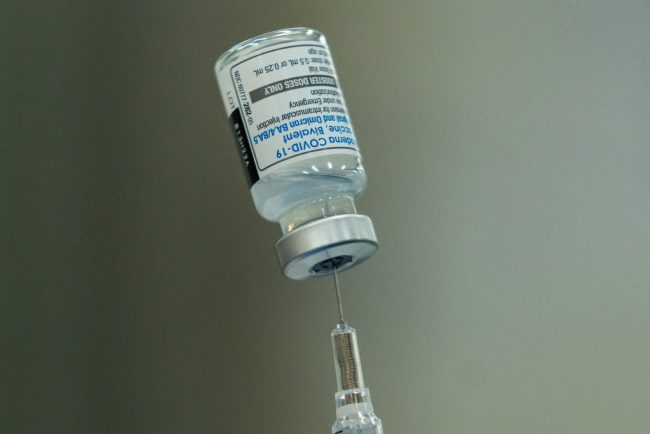
Scientists Say NIH Officials Told Them To Scrub mRNA References on Grants
National Institutes of Health officials have urged scientists to remove all references to mRNA vaccine technology from their grant applications, two researchers said, in a move that signaled the agency might abandon a promising field of medical research. The mRNA technology is under study at […]
PharmaceuticalsNational Institutes of Health officials have urged scientists to remove all references to mRNA vaccine technology from their grant applications, two researchers said, in a move that signaled the agency might abandon a promising field of medical research.
The mRNA technology is under study at the NIH for prevention and treatment of infectious diseases, including flu and AIDS, and also cancer. It was deployed in the development of covid-19 vaccines credited with saving 3 million lives in the U.S. alone — an accomplishment President Donald Trump bragged about in his first term.
A scientist at a biomedical research center in Philadelphia wrote to a colleague, in an email reviewed by KFF Health News, that a project officer at NIH had “flagged our pending grant as having an mRNA vaccine component.”
“It’s still unclear whether mRNA vaccine grants will be canceled,” the scientist added.
NIH officials also told a senior NIH-funded vaccine scientist in New York state, who does not conduct mRNA vaccine research but described its efficacy in previous grant applications, that all references to mRNA vaccines should be scrubbed from future applications.
Scientists relayed their experiences on the condition of anonymity for fear of professional retaliation by the Trump administration.
A senior official at the National Cancer Institute confirmed that NIH acting Director Matthew Memoli sent an email across the NIH instructing that any grants, contracts, or collaborations involving mRNA vaccines be reported up the chain to Health and Human Services Secretary Robert F. Kennedy Jr.’s office and the White House.
Memoli sent a similar message ahead of the agency canceling other research, such as studies of vaccine hesitancy.
Memoli’s email on that topic bluntly stated that NIH was not interested in learning why people shun vaccines or in exploring ways to “improve vaccine interest and commitment.”
The National Cancer Institute official, who also spoke on the condition of anonymity for fear of reprisals, said that “it is reasonable to assume mRNA vaccine work is next.”
The official said a similar memo also went out regarding NIH-funded work in South Africa, which the White House has targeted over false claims that the country’s government is persecuting white people. More recently, another one went out regarding all global research collaborations, the official said.
Spokespeople for the White House, HHS, and the NIH did not respond to requests for comment.
The NIH, whose latest annual budget was $47 billion, is one of the world’s most critical sources of funding for basic biomedical research. Its mission and programs are under unprecedented scrutiny from Trump’s White House and the Department of Government Efficiency, the Elon Musk-led agency created by a Trump executive order that has directed federal agencies to prepare for widespread layoffs.
The NIH is funding at least 130 studies involving the mRNA technology in covid vaccines produced by Pfizer-BioNTech and Moderna that have been administered to billions of people worldwide.
A former government official familiar with internal discussions said that the Trump administration intends to cut some grants for mRNA vaccine research but that the timing is unclear. The person spoke on the condition of anonymity to protect relationships with the administration.
Political conservatives in the U.S. have promulgated conspiracy theories, unsupported by scientific evidence, that the shots and their relatively new technology are dangerous. This has undermined public support for covid vaccinations and mRNA research.
“There will not be any research funded by NIH on mRNA vaccines,” the scientist in New York said in an interview. “MAGA people are convinced that these vaccines have killed and maimed tens of thousands of people. It’s not true, but they believe that.”
Meanwhile, hundreds of other vaccine-related studies are in limbo. Kawsar Talaat, a vaccine researcher at the Bloomberg School of Public Health at Johns Hopkins University, has been waiting since the fall for money needed to recruit subjects for a study of an antidiarrheal vaccine.
“NIH approved our funding,” she said, “and now we’re waiting, and we don’t know if it’s going forward or going to be killed.”
The scientist in Philadelphia signaled that he believes Kennedy, a longtime anti-vaccine activist, is responsible for the NIH’s turn against mRNA research.
“Kennedy’s war on vaccines has started,” the scientist told his colleague.
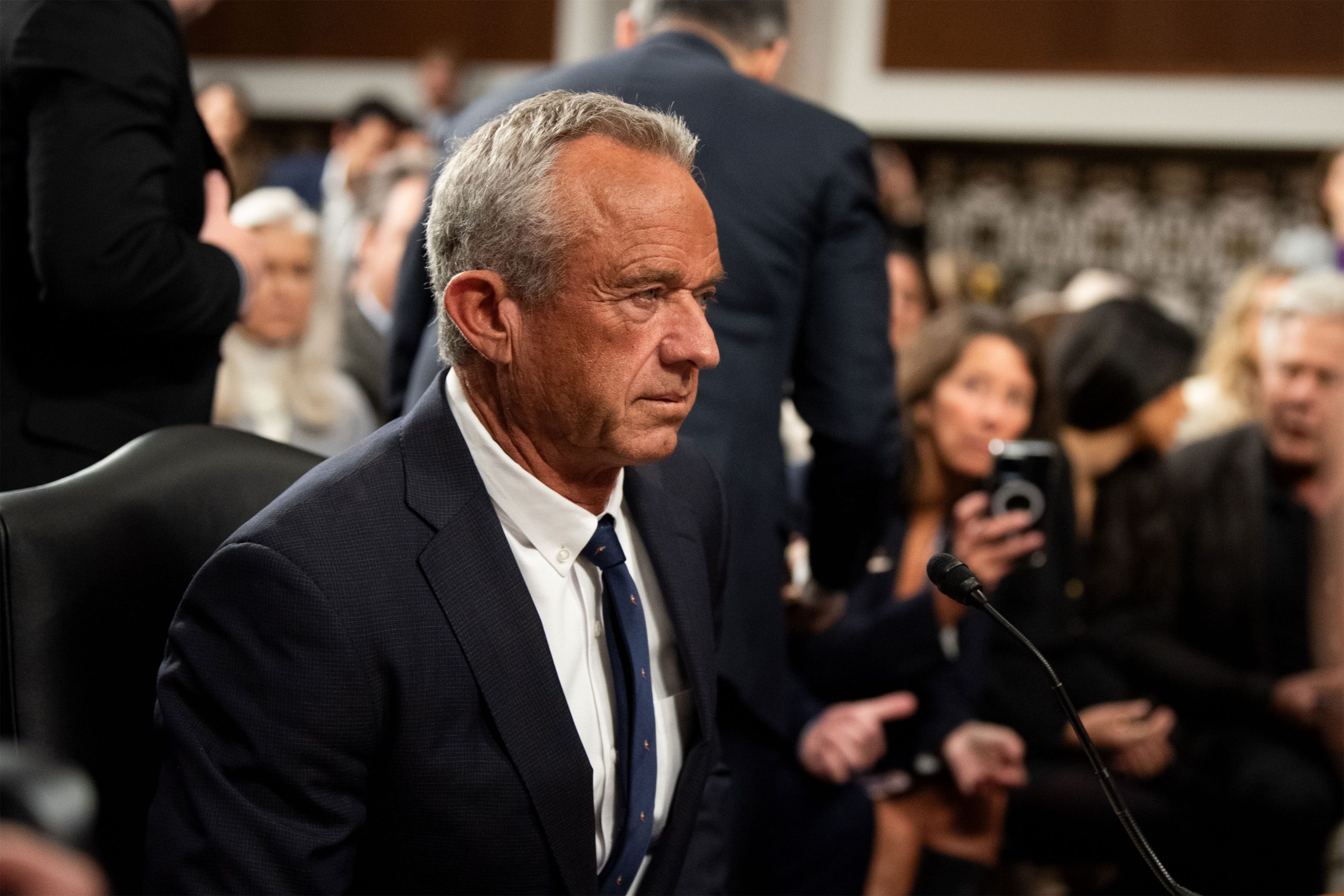
The scientist in New York said that it was “ridiculous” to remove mRNA language from the grant applications. But “if my grant is rejected for any reason,” the scientist said, “people in my lab will lose their jobs.”
“I’ve worked with some of them for 20 years,” the scientist added. “They have children and families. There is a real climate of fear in academia about this now, especially among vaccine scientists.”
“My grant does not involve a request for funds to conduct mRNA vaccine experiments,” the scientist said, “so my principal concern was to avoid word-search flags that, at minimum, would lead to delays in any funding.”
While tenured research professors at universities generally receive a salary from their institution, the staffers who work in their labs and offices are often paid through NIH grants. The 2023 Nobel Prize in physiology or medicine was given to two scientists for developing mRNA vaccines, through work that relied on pharmaceutical companies and on NIH scientists working under infectious disease specialist Anthony Fauci.
According to Sen. Bill Cassidy, a Louisiana Republican who chairs the chamber’s Health, Education, Labor and Pensions Committee, Kennedy promised during his Senate confirmation process that he would protect “the public health benefit of vaccination” and “work within the current vaccine approval and safety monitoring systems, and not establish parallel systems.”
Cassidy, a physician, had expressed reservations about confirming Kennedy to the HHS post and challenged his anti-vaccine views during a confirmation hearing. He ended up voting for him, he said, because Kennedy had agreed to work closely with Cassidy and his committee.
However, Kennedy has faced scrutiny in his first weeks in office for his handling of a large measles outbreak among mostly unvaccinated people in Texas that has led to the death of a child, the first U.S. measles death in more than a decade. A patient who tested positive for measles died in New Mexico, but the cause hasn’t been confirmed. Instead of urging vaccination against the disease, an almost surefire way to prevent infection, Kennedy has blamed malnourishment for the outbreak, promoted unproven treatments for measles, and falsely claimed in one Fox News interview that the vaccine is ineffective and even dangerous.
Cassidy did not respond to a request for comment on the NIH’s potential abandonment of mRNA vaccine research.
As part of the Trump administration’s push to examine spending on mRNA vaccines, health officials are reviewing a $590 million contract for bird flu shots that the Biden administration awarded to Moderna, Bloomberg News has reported. Legislation introduced by GOP lawmakers in at least seven states is aimed at banning or limiting mRNA vaccines. In some cases, the measures would hit doctors who give the injections with criminal penalties, fines, and the possible revocation of their licenses.
Stephanie Armour and Céline Gounder contributed to this article.
We’d like to speak with current and former personnel from the Department of Health and Human Services or its component agencies who believe the public should understand the impact of what’s happening within the federal health bureaucracy. Please message KFF Health News on Signal at (415) 519-8778 or get in touch here.
KFF Health News is a national newsroom that produces in-depth journalism about health issues and is one of the core operating programs at KFF—an independent source of health policy research, polling, and journalism. Learn more about KFF.
USE OUR CONTENT
This story can be republished for free (details).









